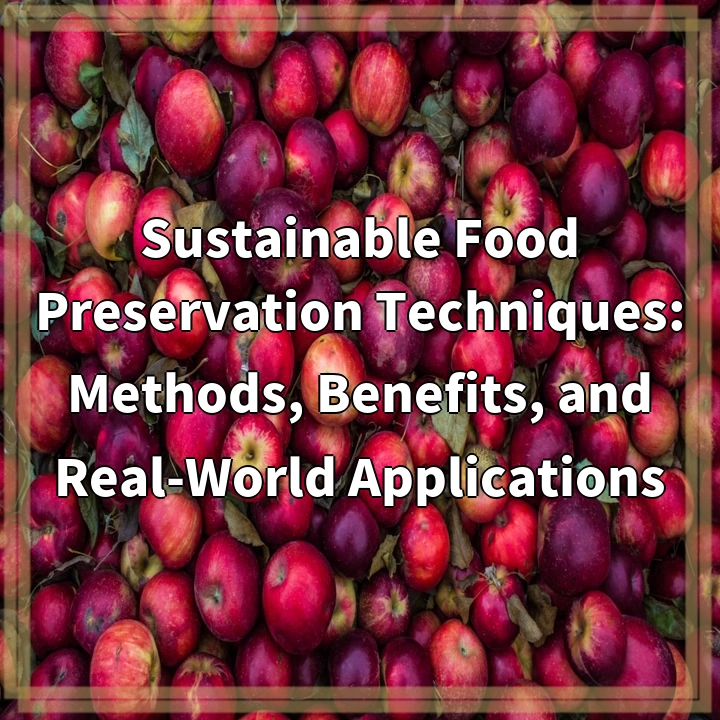
What it is:
Sustainable food preservation techniques refer to methods designed to extend the shelf life of food while minimizing waste and reducing the environmental impact of food production. These techniques encompass a variety of processes, including drying, fermenting, canning, and pickling. Each method aims to maintain the nutritional value of food and reduce reliance on chemical preservatives, which can be harmful to both health and the environment.
Methods of Sustainable Food Preservation
1. **Dehydration**: Removing moisture from food helps prevent bacterial growth and spoilage. Dehydrated foods, such as fruits and vegetables, can last for months and are lightweight for storage and transport.
2. **Fermentation**: This ancient practice not only preserves food but also enhances its nutritional value. Foods like yogurt, sauerkraut, and kimchi undergo fermentation, which increases their shelf life while adding beneficial probiotics.
3. **Canning**: This method involves sealing food in airtight containers and heating them to kill bacteria. Canning is energy-intensive but can be made more sustainable by using locally sourced ingredients and minimizing energy consumption through batch processing.
4. **Pickling**: By soaking foods in vinegar or brine, pickling creates an acidic environment that inhibits spoilage. This technique can be applied to a variety of fruits and vegetables, making them shelf-stable for long periods.
Benefits of Sustainable Food Preservation
Sustainable food preservation not only helps reduce waste but also offers numerous benefits for health and nutrition. These methods can help maintain the food’s essential nutrients and flavor while promoting a more circular economy. Consumers benefit from extended access to seasonal produce and a reduction in grocery bills due to less food waste.
Real-World Problems
Despite the advantages of sustainable food preservation techniques, several real-world problems persist. First, there is a lack of knowledge and resources in many communities regarding these methods. Educational initiatives are essential to empower individuals and families to adopt sustainable practices, as many traditional methods have faded from common use.
Second, industrial food systems often rely on large-scale processing and reliance on preservatives that compromise the sustainability of food preservation. The emphasis on convenience often overshadows traditional methods, leading to a higher rate of food waste and environmental degradation.
Lastly, socioeconomic factors play a significant role in food accessibility. Low-income communities may lack access to fresh produce or the equipment needed for effective preservation, limiting their ability to embrace sustainable techniques. Addressing these disparities is crucial for promoting equitable food preservation practices and ensuring that everyone can benefit from sustainable options.

Solutions to Sustainable Food Preservation Challenges
To effectively address the challenges outlined in sustainable food preservation techniques, several solutions can be implemented. These solutions focus on education, community engagement, resource accessibility, and promoting traditional methods.
1. Education and Outreach
Increasing awareness about sustainable food preservation techniques through community workshops and educational programs is essential. Schools, local organizations, and agricultural extension services can offer classes on methods such as dehydration, fermentation, and pickling, enabling individuals to gain hands-on experience.
2. Community Initiatives
Building community support networks can help share resources and knowledge. Local food cooperatives, community gardens, and farmer’s markets can provide access to fresh produce and foster collaboration among residents to maintain these traditions. Additionally, community kitchens can serve as shared spaces for food preservation activities.
3. Accessibility of Resources
Ensuring that individuals in low-income communities have access to preservation tools and fresh ingredients is vital. Subsidized equipment programs and partnerships with local farms can contribute to breaking down financial barriers, allowing more people to practice sustainable food preservation.
4. Promotion of Traditional Methods
Reinforcing the value of traditional and artisanal food preservation techniques can help revive interest in sustainable practices. Highlighting local success stories and incorporating these methods into modern culinary practices can inspire individuals to adopt sustainable habits.
5. Policy Advocacy
Encouraging policy changes that support sustainable food systems is essential. Advocating for support for local food producers, sustainable agriculture initiatives, and nutrition education programs can help create an environment conducive to sustainable food preservation.
Implementing these solutions not only enhances the effectiveness of sustainable food preservation techniques but also fosters a more resilient and environmentally-friendly food system. By empowering communities, preserving knowledge, and increasing accessibility, we can make a meaningful impact on reducing food waste and promoting sustainability.















